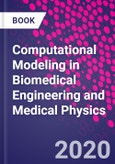Mathematical and numerical modelling of engineering problems in medicine is aimed at unveiling and understanding multidisciplinary interactions and processes and providing insights useful to clinical care and technology advances for better medical equipment and systems. When modelling medical problems, the engineer is confronted with multidisciplinary problems of electromagnetism, heat and mass transfer, and structural mechanics with, possibly, different time and space scales, which may raise concerns in formulating consistent, solvable mathematical models.
Computational Medical Engineering
presents a number of engineering for medicine problems that may be encountered in medical physics, procedures, diagnosis and monitoring techniques, including electrical activity of the heart, hemodynamic activity monitoring, magnetic drug targeting, bioheat models and thermography, RF and microwave hyperthermia, ablation, EMF dosimetry, and bioimpedance methods. The authors discuss the core approach methodology to pose and solve different problems of medical engineering, including essentials of mathematical modelling (e.g., criteria for well-posed problems); physics scaling (homogenization techniques); Constructal Law criteria in morphing shape and structure of systems with internal flows; computational domain construction (CAD and, or reconstruction techniques based on medical images); numerical modelling issues, and validation techniques used to ascertain numerical simulation results. In addition, new ideas and venues to investigate and understand finer scale models and merge them into continuous media medical physics are provided as case studies.
Please Note: This is an On Demand product, delivery may take up to 11 working days after payment has been received.
Computational Medical Engineering
presents a number of engineering for medicine problems that may be encountered in medical physics, procedures, diagnosis and monitoring techniques, including electrical activity of the heart, hemodynamic activity monitoring, magnetic drug targeting, bioheat models and thermography, RF and microwave hyperthermia, ablation, EMF dosimetry, and bioimpedance methods. The authors discuss the core approach methodology to pose and solve different problems of medical engineering, including essentials of mathematical modelling (e.g., criteria for well-posed problems); physics scaling (homogenization techniques); Constructal Law criteria in morphing shape and structure of systems with internal flows; computational domain construction (CAD and, or reconstruction techniques based on medical images); numerical modelling issues, and validation techniques used to ascertain numerical simulation results. In addition, new ideas and venues to investigate and understand finer scale models and merge them into continuous media medical physics are provided as case studies.
Please Note: This is an On Demand product, delivery may take up to 11 working days after payment has been received.
Table of Contents
1. Physical, Mathematical and Numerical Modeling Essentials
2. Constructal Law criteria in morphing shape and structure of systems with internal flows
3. Computational domains
4. Electrical activity of heart
5. Bioimpedance methods
6. Magnetic drug tartegting
7. Magnetic stimulation
8. Hyperthermia and ablation (Thermotherapy methods)








